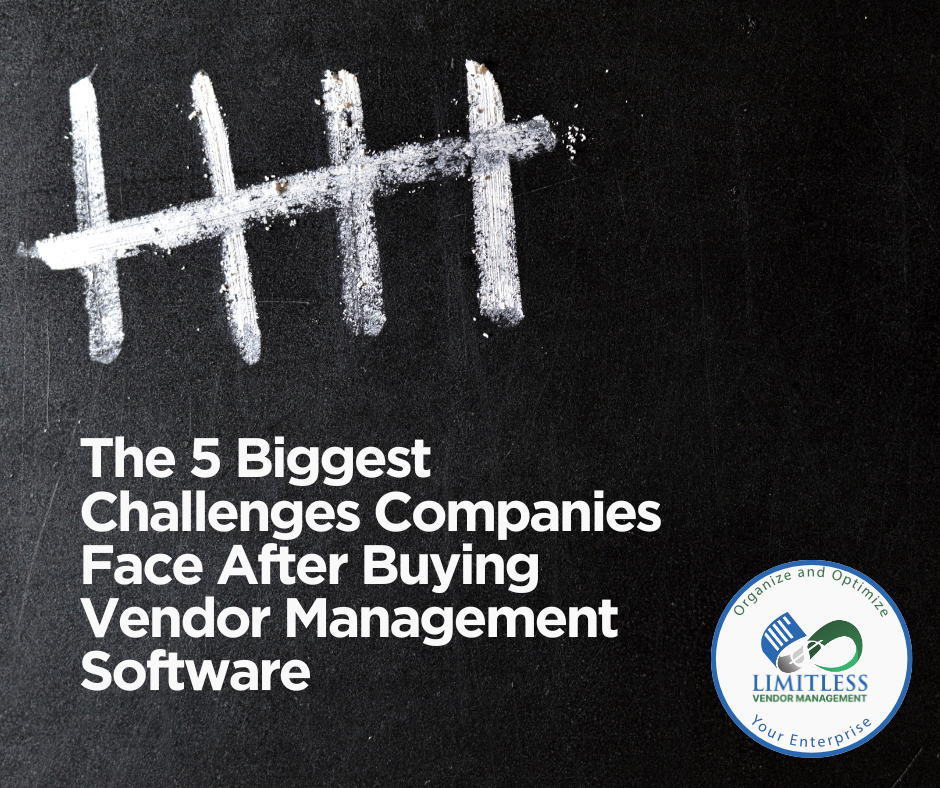Vendor management software is often marketed as the all-in-one solution for streamlining supplier relationships, automating contracts, and reducing costs. While the promise sounds great, the reality is that many companies—especially midsized to large enterprises—face significant roadblocks after the software is purchased.
Here are the five biggest challenges businesses encounter after implementing vendor management software, and what you can do instead to get the results you’re actually looking for.
- Software Implementation is More Complex Than Expected
Most vendor management platforms require significant setup, configuration, and integration with your existing systems. That can mean delays in onboarding, IT bottlenecks, and data migration headaches.
Common problems include:
- Incompatibility with current systems
- Long deployment timelines
- Unexpected consulting or setup fees
- Confusing user interface and workflow errors
What was supposed to be a time-saving tool can quickly drain your team’s energy and budget before it’s even operational.
- Employees Struggle to Learn and Adopt the System
Even the best software is only effective if people use it—and use it correctly. The problem? Many platforms are overly complex and not intuitive for non-technical users.
Training challenges include:
- Steep learning curves across departments
- Resistance to changing familiar workflows
- Repeated training due to staff turnover
- Inconsistent usage and data entry errors
Without proper training and support, adoption lags and vendor issues continue to slip through the cracks.
- No One is Truly Managing the Vendors
After the system is in place, many companies find themselves in the same position they were before—except now they have a costly platform and no clear strategy.
This leads to:
- Missed contract renewal dates
- Undetected billing errors
- Overlooked vendor underperformance
- Lack of visibility across departments
Without dedicated oversight, software becomes just another tool collecting digital dust.
- Administrative Burden Shifts, Not Disappears
Instead of reducing the workload, many companies find that vendor software shifts the administrative burden on employees who already have full-time responsibilities. Now, they’re expected to:
- Upload, update, and organize contract files
- Track vendor certificates and compliance
- Manually flag issues or follow up on renewals
What should be an automated solution ends up requiring constant manual effort just to maintain.
- There’s No Strategic Insight—Just Data Overload
Software platforms are great at collecting data, but not at interpreting it. You may have dashboards filled with charts, graphs, and logs—but without the expertise to analyze and act on that information, you’re left with more noise than clarity.
You don’t need more data.
You need actionable insight.
The Solution? A Hands-On, Expert-Led Process
At Limitless Vendor Management, we go beyond software.
We partner with your business to not just digitize—but optimize—your vendor relationships. Our team becomes an extension of yours, taking full ownership of your vendor landscape while giving you full transparency and control.
We help you:
✅ Collect and organize all vendor documentation
✅ Audit vendor contracts and billing for inconsistencies
✅ Manage renewals, licenses, and compliance
✅ Negotiate stronger terms directly with vendors
✅ Identify cost-saving opportunities
✅ Eliminate the manual burden from your internal teams
If your team is overwhelmed, your vendors are unmanaged, and your expensive VMS isn’t delivering value—it’s time to stop relying on software alone.
What your business needs is a strategy. A team. A partner.
Ready to take control of your vendor costs and eliminate hidden inefficiencies?
Stop relying on one-size-fits-all software and partner with a team that delivers real results.
Contact Limitless Vendor Management today to schedule your consultation and start optimizing smarter.

